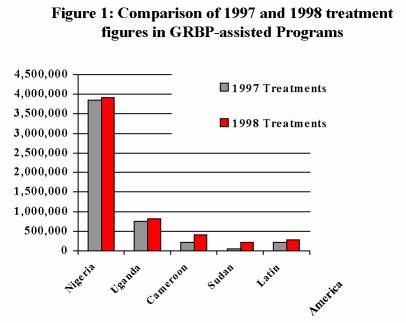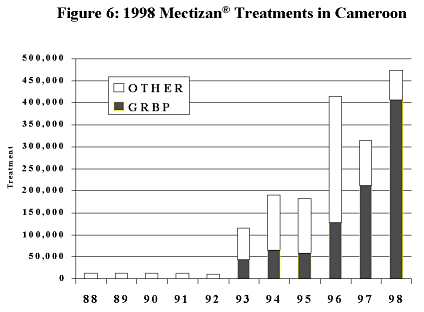1998 GRBP THIRD ANNUAL GRBP PROGRAM REVIEW HELD
IN ATLANTA,GA The Global 2000 River Blindness Program (GRBP) hosted its third annual program review meeting for Cameroon, Nigeria, Uganda, Sudan and Latin America on February 17th-19th, 1999 at The Carter Center in Atlanta. In attendance were GRBP country representatives [Dr. Albert Eyamba (Cameroon), Mr. Moses Katabarwa(Uganda), Dr. Emmanuel Miri (Nigeria), Dr. Mauricio Sauerbrey (OEPA)] who presented their 1998 treatments, on-going assessment activities, 1999 treatment objectives, sustainability, program funding status, issues of Mectizan®security & the 3mg tablet transition, and the APOC transition. Also in attendance in addition to Global 2000 staff were: Prof. Mamoun Homeida(Chairman, NOCP Sudan), Ms. Irene Goepp (Program Manager, HealthNet, Sudan),representatives from the Mectizan® Donation Program (Drs. Meredith,Dull and Alleman), Dr. Brian Bagnall (Smith Kline Beecham), Dr. Charle sMackenzie (Michigan State University expert on Sudan), and Mr. Jeremy Horowitz(Helen Keller International).
The objectives of the review meeting were to:
1) assess the status of each program,
2)assess impediments and challenges to program implementation and discuss possible solutions,
3) promote sharing and standardization of information,
4) discuss APOC implementation and status,
5) discuss Mectizan®security issues, and
6) measure progress towards sustainability.
In 1998, GRBP programs assisted in the treatment of 5,626,767 persons with Mectizan®(93% of the GRBP 1998 Annual Treatment Objective) (ATO). This is an increase of 10% compared to treatments provided in 1997. Of all treatments in 1998,3,766,868(67%) were carried out in partnership with the Lions Clubs Sight First program (LCIF) in Nigeria, Cameroon, and Sudan. Most 1998 treatments were administered in Nigeria (69%), with 15% in Uganda, 7% in Cameroon, 5% in Latin America (OEPA), and 4% in Sudan.
Key recommendations from the review meeting included:
1) continued emphasis on monthly reporting of Mectizan® treatments related to defined objectives,
2) continued monitoring of financial and administrative experiences with APOC in Cameroon,Nigeria, Sudan, and Uganda,
3) establishment of a mechanism to manage the transition from 6mg to 3mg tablets in all GRBP programs,
4) continued sustainability monitoring, and
5) continued monitoring of transmission interruption in Latin America.The GRBP Annual Treatment Objective (ATO) for eligible-at-risk population (earp) projection for 1999 is 6.7 million, a 15% increase compared to 1998.

UGANDA: THE 3MG TABLET TRANSITION
The Uganda program treated 15% of all GRBP treatments in 1998. A total of 827,677 persons were treated, 98% of its 1997 ATO, and 78% of all Ugandan treatments provided by both indigenous and international NGDOs (1,067,951). Coverage rates in Kasese (81%) and Kisoro (83%) were lower than average in Uganda due to insecurity and personnel issues there. Overall, program performance in 1998 was the best compared to annual coverage rates from 1993- 1998.A closer examination showed that this was primarily due to individual communities attaining high coverage rates (90% of them achieving the desired coverage rate of 80% and above).
Uganda has had the most experience with the newly introduced 3 mg Mectizan® tablet of all GRBP programs. First proposed in 1988 during a joint meeting of the Mectizan® Expert Committee, WHO, and Merck, the changes came about due to concerns from the field that breaking the 6mg tablets to obtain the correct dose was in conveniencing, and difficult when treating enmasse.
In 1993, Merck announced plans to produce the new 3mg tablet. Production begun in 1997,and in 1998 shipments of the drug were sent to country programs. The new 3mg tablet is smaller than the 6mg tablet, and contained in a bottle with 500 tablets. The opening of the bottle is covered with an inner protectivef oil seal. As long as the seal remains intact, and in ideal storage conditions,the potency of the drug is retained for 2 years after production. Stability tests conducted to date indicate that once the seal is broken, the tablets retain full potency for only six to eight weeks there after. This has programmatic implications which must be considered carefully in scheduling treatments for 1999.
One of the challenges some treatment programs has been explaining to people why they now have to take what seems like a "double dose" of Mectizan®. In Uganda, however,this has not been the case. Even though the dosage remains the same, the treatment with more tablets is perceived to be even more effective.
In 1998, a total of 2505 CDDs were trained in 6 districts. In Uganda, the contribution of community members to the success of the program includes more than direct community participation. Observation shows that although a majority of trained CDDs stay in their respective communities even when they are not be available to participate in mass treatment activities, their presence has a positive effect on the program. They are believed to positively influence the community, thus encouraging drug compliance.
No rapid assessment activities were reported for 1998 in Uganda. The program reports the numbers of high-risk villages as equal to at-risk villages. Due to the lack of sufficient data to distinguish between at-riskand high-risk villages.
NIGERIA: PROGRESS TOWARDS SUSTAINABILITY
In 1998, Nigeria provided 3,912,476 treatments, 97% of its ATOearp. These treatments were administered in 9471 at-risk villages, and 7092 high risk villages, representing 90% and 102% of the ATOarv and ATOhrv. In areas where GRBP and LCIF arein partnership, 3,255,265 treatments were administered (83% of all GRBP treatments). This represented an increase in LCIF supported treatments in Nigeria by 3%. Since the Nigeria program has reached complete coverage in its treatment areas, 1999 projected treatments are not expected to differ significantly from 1998.
The program in Nigeria continues to monitor progress towards sustainability . In 1998,it was noted that of the 9,099 CBDs involved in distribution activities in GRBP supported areas, 6,342 (70%) received support from the community.In the Enugu/Eboni/Anambra project, for example, 2,547 of the 3,026 (84%)high-risk village representatives completed acceptance forms indicating their commitment to compensate CBDs. Of these, 1761 (69%) actually compensated them.
A significant challenge to the program in 1998 was fuel scarcity. It is expected to remain the same in 1999.

SUDAN: SIGNIFICANT PROGRESSAS REPORTING IMPROVES.
In 1998 The Sudan Onchocerciasis Control Program significantly increased the level of treatment activity despite difficult working conditions.
From January to December 1998, a total of 280,199 persons received Mectizan® treatments in Sudan. Of all Sudan treatments 57% (160,985) were administered in the north, and 43% (119,214) in the south. Treatments in Sudan were significantly higher in 1998 compared to 1997: an increase of over 700% in the north,and 170% in the south. Overall in Sudan, over 300% more treatments were administered in 1998 compared to1997.
Support from the LCIF project was significant in 1998 as in previous years. Of the 1998 treatments, 74% were achieved with LCIF/GRBP support (208,711). Seventy-seven percent of these treatments (160,985) were carried out by the NSOCP (The Government of Sudan), and 23% by the SSOCP (47,726). The total number of treatments administered with LCIF support in 1998 (208,711) represent over a 300% increase compared to 1997 (47,139).
Obtaining eligible at risk population data in Sudan is understandably difficult due to the civil unrest resulting in frequent migrations in and out of endemic areas.In 1998 the GOS was involved in re-census activities aimed at refining population data. In the south, Operation Life line Sudan has established a data monitoring and evaluation task force to refine population information.Such efforts will continue in 1999.
The performance of the Sudan program was noteworthy, especially due to the challenges faced in 1998. Some of these included :
In 1998, ivermectin distribution activities took place despite difficult circumstances in Sudan:
 OPEA: EYESON GUATEMALA
OPEA: EYESON GUATEMALA| YEAR | # of REA | % |
|---|---|---|
| 1994-96 | 102 | 10.2 |
| 1997 | 270 | 27 |
| 1998 | 627 | 62.8 |
| TOTAL | 999 | 10 |
Guatemala now represents the greatest challenge to the American initiative. It is estimated that there are over 430,000 persons at risk of infection with the parasite that causes onchocerciasis. Guatemala is second to Venezuela as the most endemic country for river blindness in the Americas. Despite great progress made in 1994 to treat 125,000 persons, the program has not been able to attain the same level of treatment again. In 1998, 92,800 treatments were provided in Guatemala.
CAMEROON:EXPANSION IN WEST PROVINCE, INCREASING COVERAGE..?
The Cameroon program provided 407,281 treatments in 1998. This was an increase of 92% compared to 1998. Of the treatments administered in Cameroon, 302,892 (74%)were administered in partnership with the LCIF.
In October 1998 the National Immunization Days were scheduled at the same time as the peakivermectin treatment period for GRBP programs in Cameroon. All health personnel were mobilized for immunization activities, there by reducing the numberof people available to supervise treatments. This resulted in poor treatment coverage in October.
In 1999, theCameroon program plans to treat 600,000 which is about the same target population as in 1998. In 1998 there were significant increased in treatment areas due to expansion activities in the West province. In 1999 no expansions are expected to take place. Eligible at risk population data is therefore expected to be refined this year.

MEETINGS:
Dr. Richards,Mr. Agle, and Mr. Robinson attended a meeting with representatives fromThe Inter American Development Bank (IBD) in September, in Guatemala. The purpose was to discuss an extension of the IDB grant through the year 2000.
Under the auspicesof the Federal Ministry of Health, a combined meeting of the Nigerian national guinea worm eradication program, the national lymphatic filariasis elimination program, the national schistosomiasis control program, and the Nigeria GRBP will took place in Abuja, Nigeria, in October 28-30, 1998. This was the first such joint review ever held for the four programs in Nigeria.
The third Annual GRBP program review meeting was held at The Carter Center in Atlanta, GAUSA, from February 17th -19th, 1999. Detailed summary proceedings will be available for circulation.Prof. Homeida and Dr. Bagnall were guest speakers at the Board of Councillors meeting on Thursday February 18th,1999. Prof. Homeida spoke on the importance of Peace and Health in Sudan, and Dr. Bagnall addressed the special partnership between the Carter Center and Smith Kline Beecham in the fight against lymphatic filariasis
A workshop on"Effective and efficient Drug Distribution for the Elimination of Lymphatic Filariasis" was held in Annecy, France from February 24th- 26th,1999. The workshop was organized by Health and Development International(HDI) in collaboration with WHO. The objective of the workshop was to discuss angles related to the supply chain of tablets for distribution for the elimination of lymphatic filariasis (related especially to coordination of albendazole and ivermectin tablet delivery in Africa). Drs. Miri and Richards participated in the workshop where they chaired two of the four working groups.
The meetings of the NGDO Coordination Group for Ivermectin Distribution (March 19th-20th),and the Technical Consultative Committee (March 22nd- 26th),will be held in Ouagadougou, Burkina Faso. Dr. Richards will be in attendance representing The Carter Center.
During the last NGDO coalition meeting in Uganda held in November, Mr. Moses Katabarwa(GRBP country representative) was nominated and confirmed chairman of the NGDO coalition.
Selected References
KatabarwaMN; Mutabazi D.The Selection and Validation of Indicators for Monitoring Progress Towards
Self-Sustainment in Community-Directed, ivermectin-Treatment Programmes for Onchocerciasis Control in Uganda. Annals of Trop Medand Parasitol, 1998, 92 (8): 859-868 .
Onchocerciasis(River Blindness) Report from the Seventh Inter American Conference on Onchocerciasis,Cali, Colombia. Weekly Epidemiological Record. 1998 (?)
KatabarwaMN; Mutabazi D; Richards FR Jr. Ivermectin Distribution for Onchocerciasis in Africa. The Lancet, 1998; 353: 757.
Please sign up below for important news about the work of The Carter Center and special event invitations.